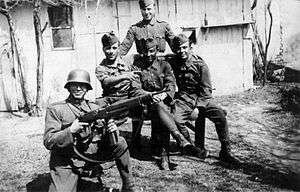Danuvia 43M submachine gun

| Danuvia 39.M | |
|---|---|
|
Hungarian soldiers in the Carpathians in 1944, the kneeling soldier displaying his Danuvia 39.M. | |
| Type | Submachine gun |
| Place of origin |
|
| Service history | |
| In service | 1939 to early 1950s |
| Used by | Hungary |
| Wars | World War II |
| Production history | |
| Designed | 1930s |
| Produced | 1939–1945 |
| Number built | ~8,000 to 10,000 |
| Variants |
39M - Wooden stock version 39M/A - Folding wooden stock version 43M - Modernized version |
| Specifications | |
| Weight |
3,63 kg without magazine 4,46 kg with magazine |
| Length | 953/749 mm |
| Barrel length | 424 mm |
|
| |
| Cartridge | 9 mm Mauser Export |
| Action | Lever-delayed blowback |
| Rate of fire | 750 round/min |
| Muzzle velocity | 450 m/s (1,476 ft/s) |
| Feed system | 40 rounds |
The 9×25mm Danuvia submachine guns (Király géppisztoly) were designed by Hungarian engineer Pál Király in the late 1930s. They were issued to Hungarian army troops in 1939 and remained in service throughout World War II until the early 1950s. A total of roughly 8,000 were made between 1939 and 1945. The Danuvia was a large, sturdy weapon, similar to a carbine. Although inspired by the 9×19mm Parabellum Beretta Model 38/42, the Danuvia used the more powerful 9×25mm Mauser round. Like the Beretta, the Danuvia's magazine can be folded forward into a recess in the stock where a plate then slides over it.
The original Danuvia was the 39M: it was redesigned in 1943 as the 43M. This, the most common version, had a shortened barrel and was provided with a forward-angled magazine. It had a folding metal buttstock and wood forestock fitted with a pistol grip. The Danuvia featured a patented two-part delayed blowback bolt. The fire selector switch is a circular cap on the rear of the receiver and is rotated to one of three settings: E (Egyes)(semiautomatic fire), S(Sorozat) (full automatic), or Z (Zárt)(the safety setting). The ejection port and cocking handle are on the right side of the receiver. It had a ramp-type rear sight above the ejection port and a post foresight at end of the barrel.
The gun was well-liked by troops it was issued to; it reportedly functioned well in the sub-zero, muddy conditions on the Eastern Front. The only difficulty was the availability of 9×25mm Mauser ammunition. It was used by the Hungarian army, military police and police forces and stayed in service until the early 1950s when it was gradually replaced by the PPSh-41 and the Kucher K1.
External links
- About guns (hu)
- Magyar Handguns (hu)
- Art of war (hu/en)
- Some words (hu)
- Some word from dessant solgers (hu)
- Danuvia (39M) (en)
- Danuvia (43M) (en)
- Some words (ru)
- submachine guns (en)
